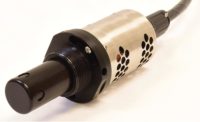Let’s first state the obvious. Most techs are intimidated by Psychrometric charts and Mollier diagrams, we just are. While there are some pretty complicated formulas that back up these diagrams, using them isn’t a big of a deal once you understand the different elements and then focus on one at a time.
Dew point is one example of a very useful measurement to understand, design for and test for in an HVAC/R system. Take an evaporator coil, do you know how to calculate the exact temperature at which that evaporator coil will start to condense moisture? can you tell the exact temperature at which a surface inside of a space will start to condensate and possibly grow mold? These are both cases where a basic understanding of a psychrometric diagram can help a technician.
While some of the elements on the chart are represented by curved or slanted lines, dew point temperature and humidity ratio / absolute moisture content are just straight lines horizontally across the chart.
So if we focus on a 65°F(18.33°C) dew point on the right side of the chart you will notice it crosses over 92 grains (there are 7000 grains of moisture per lb) of moisture line and then goes all the way across until it intersects with the curved 100% humidity line on the left side. This shows us that at a 65°F(18.33°C) dew point the air always contains 92 grains of moisture per lb.. Always.
This also shows us that when the air is at 100% relative humidity the dew point, wet bulb and dry bulb temperatures are all the same.
If we have a dew point of 55°F(12.77°C) the air contains 64 grains of moisture per lb. If the dew point is 30°F(-1.11°C) the air contains 24 grains… you get the point.
So now if you find the dry bulb temperature and the relative humidity you can easily calculate the dew point at which that same air will reach saturation and begin to form condensation.
Let’s say we have 75°F(23.88°C) dry bulb air at 50% relative humidity. We would simply draw a line up from the bottom at 75°F23.88°C) until we hit the curved 50% line. Then go right (or left) until you bump into the the grains of moisture and then the dew point scale. Now you know at what temperature that same air mass will start to condense water.
So we can see that this if this 75°F(23.88°C) dry bulb 50% relative humidity mass of air comes in contact with a surface that is 55.5°F(13.05°C) or less, it will begin to condense water. We also know that this air stream contains 65 grains of moisture per lb of air.
Forgive me for saying so, but I think this is pretty cool.
Want more HVAC industry news and information? Join The NEWS on Facebook, Twitter, and LinkedIn today!








